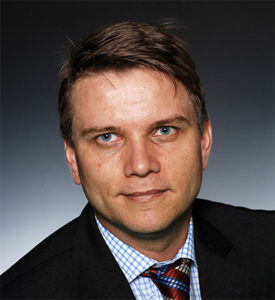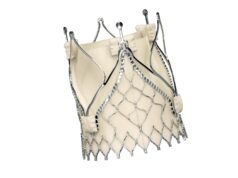 Christoph Naber (Essen, Germany) talks to Cardiovascular News about his career in interventional cardiology. Known for his work in the Stent–Save a Life campaign, he has also served as a course director for AsiaPCR, and co-director for the EuroPCR and PCR London Valves events, and more recently has helped to found the We CARE campaign, in response to the COVID-19 pandemic.
Christoph Naber (Essen, Germany) talks to Cardiovascular News about his career in interventional cardiology. Known for his work in the Stent–Save a Life campaign, he has also served as a course director for AsiaPCR, and co-director for the EuroPCR and PCR London Valves events, and more recently has helped to found the We CARE campaign, in response to the COVID-19 pandemic.
This profile features in Issue 62 of Cardiovascular News.
Why did you choose to become a doctor and to specialise in interventional cardiology?
When I was 18 years old I carried out civil service in a local hospital, where they let me work virtually everywhere. I decided I wanted to become an intensive care nurse, but the head nurse of the ward strongly recommended I study medicine and I took his advice.
One thing that really bothered me was the treatment of ST-elevation myocardial infarction (STEMI) patients. We resuscitated them if needed, and if they were lucky they left the hospital after six weeks. One of my closest friend’s fathers died from his second heart attack and there was virtually nothing we could do, as thrombolysis was only performed in trials in large academic centres and percutaneous coronary intervention (PCI) was not yet available for this indication in clinical practice.At the end of my time at Bochum University I had the chance to see my first “plain old” balloon angioplasty (POBA) in the cath lab. I still remember the sound of the in-deflator and the electrocardiogram (ECG) showing ST-segment elevations, which were gone after deflation of the balloon. This was unbelievable! I was immediately sold, and spent the rest of my internship reading about the BENESTENT trial, Antonio Colombo’s reasoning on high pressure stent-implantation, and the early trials on facilitated PCI in STEMI patients.
Who have been your career mentors?
I had the privilege to work with many impressive colleagues who helped me find my way. Many were heroes in my training, but may not be known to the international community. When I joined the team of Raimund Erbel in Essen, I was placed in the cath lab almost from day one. I met Michael Haude, who was head of the cath lab at that time. He was strict, but an outstanding interventionist and a systematic teacher. He forced us to assist and watch until we could anticipate his next step, and established the basis of all I know today. Years later, David Barrow, a British journalist who worked in the medical industry introduced me to Jean Fajadet. His natural, elegant, and effective approach is unique, but his attitude really changed my perspective. Whatever he does is always intended to meet his patients’ needs. The most impactful person I worked with was Jean Marco. I met him through Magali Breheret, an outstanding facilitator and mediator herself, who worked closely with him to introduce the principles of adult education into interventional courses. This impacted my understanding of interventional cardiology and changed the way I understand the needs of patients and colleagues.
What has been the most important development in interventional cardiology during your career?
Without doubt it is transcatheter aortic valve implantation (TAVI)—the very best elective indication we have today. I remember Martin Leon presenting the results of the PARTNER trial in 2010 with Alain Cribier sat in the front row. “Percutaneous valve implantation is the gold standard for patients with very high or prohibitive surgical risk,” he said—this was a moment of history!
As part of the team that carried out Germany’s first TAVI procedure in 2004 what is your view of the evolution of TAVI?
TAVI has come a long way since those early days. In 2004 it took the team, led by Stefan Sack and proctored by Alain Cribier, several hours to implant the valve. Now this is routine, and, if well prepared, can be done in around an hour. Complication rates have fallen and are competitive. We have excellent data for lower-risk patients and I believe the durability debate is now a rearguard battle. The future falls into access to care. Economic factors play a large role in the discussion, both in developing and industrialised countries.
What has been the biggest disappointment?
Unfortunately, absorbable scaffolds. The principle to “leave nothing behind” is intuitively right, and is the ultimate evolution of PCI. My clinical experiences were excellent and I still believe the method will be back before I retire. The basic principle of implanting absorbable devices as a kind of framework for the body to restore its natural structures is fascinating and can extend to many fields beyond coronary intervention.
What are your current research interests?
I am currently working in the field of access to care. Together with a team within the European Society of Cardiology (ESC), collecting data on cardiovascular interventions in more than 30 European countries. A key element is to understand how interventions are or can be implemented in our societies. The scary thing is that the databases in most countries are extremely poor or biased. My clinical research interest is also aimed in a similar direction—how do we propose the right treatment for the right patient? Alongside a consortium of scientists, physicians and payers, we initiated a trial to look at the indication for invasive diagnostics and PCI.
What led to the creation of the Stent–Save a Life! campaign?
Stent–Save a Life! is the global successor of the European Stent for Life campaign which was founded by the PCR family, the European Association of Percutaneous Cardiovascular Interventions (EAPCI) and the ESC in 2009. It was a joint discussion between the chairmen of PCR, William Wijns and Jean Fajadet, the president and incoming president of EAPCI, Michael Haude and Andreas Baumbach, and myself as chairman of Stent for Life to extend this project globally, in around 2016. Since then Stent–Save a Life! has become an incredible success with local initiatives on four continents, endorsed by the large interventional societies.
 What success has the campaign had in improving patient access to primary PCI and where does it go next?
What success has the campaign had in improving patient access to primary PCI and where does it go next?
From a European perspective, we had to change many perspectives. Instead of only promoting primary PCI for STEMI, we chose to aim at the building of local networks, as this is where the power of such initiatives comes from. We asked new countries to build local networks and to deliver the optimal available care to all STEMI patients in their respective regions. What the currently available optimal care is may vary from region to region and depends on the available resources. But, whatever it is, it is the best starting point and it will save lives. The ultimate goal remains access to primary PCI for all STEMI patients around the globe.
We CARE is your most recent project. How is this addressing the challenges created by the pandemic?
We CARE is a platform built jointly by Stent–Save a Life! and PCR, supported by an unrestricted grant from Medtronic. At the outset of the COVID-19 crisis, many authorities postponed non-essential procedures until the outbreak could be better understood and contained. Societies were simply not prepared. Too many patients stayed away, even in life-threatening situations. We CARE is inviting thousands of interventional cardiologists and medical colleagues from around the world to take part in reversing this trend. To support them, the initiative is working on tools and guidelines to help prevent procedure postponement, encourage them to accelerate the implementation of telemedicine, and ensure the preparedness of healthcare systems.
Looking back over your career what has been your most memorable case?
The most memorable cases are not about techniques, but the trust and the relationship between physician and patient. One I will never forget was one of my first TAVI patients at the Contilia Heart and Vascular Centre in Essen—an 80-year-old lady who told me after TAVI that, despite feeling well, she did not feel the same person as before. Something had changed during the procedure. Using computed tomography (CT) of the brain we could show that she had multiple emboli, which we thought to be a consequence of the implantation. This was at the very time many publications targeted this problem, and was the reason I later engaged in stroke protection during TAVI. To finish her story, this lady remained my patient until she passed away, but her feeling of being someone else never went away. “First, do no harm” has many different aspects.
Outside of medicine, what are your hobbies and interests?
I love endurance training and do triathlons—there is something meditative about the training. I finish races in the last third, but as I race against myself, I always win! I also play golf, which is a great opportunity to play with friends from the interventional community all over the world. I love music, particularly classical, jazz and blues, and I played drums in my youth, although now it is mainly guitar. Travelling is something I never like to miss—in particular Greece, where my wife’s family is from, and India, which always touches my heart in a special way.
Fact File
Appointments (selected past and present)
Head of Cardiology and Intensive Care Medicine, Klinikum Wilhelmshaven, Wilhelmshaven, Germany
Senior consultant at the West-German Heart Centre, University of Essen, Essen, Germany
Interventional fellowship, Cardiology Cath Lab, Clinique Pasteur, Toulouse, France
Memberships (selected)
Past-chair of the Working Group on Interventional Cardiology, German Society for Cardiology (DGK)
Executive board of the European Association of Percutaneous Cardiovascular Interventions (EAPCI)
Fellow of the European Society of Cardiology (ESC)
Fellow of the Asian Pacific Society of Interventional Cardiology (APSIC)
Education
First year resident, Department for Cardiology, Angiology und Pneumology, Heinrich-Heine-University, Duesseldorf, Germany
Post-doctoral Fellow, Institute for Pharmacogenetics, University Hospital Essen, Essen, Germany
Fellow, Department of Cardiology, West-German Heart Center, University Hospital Essen, Essen Germany










